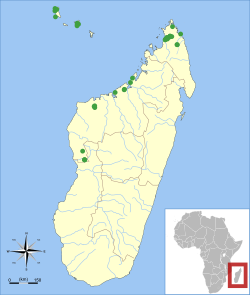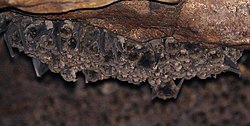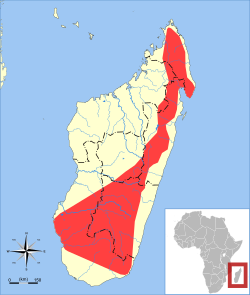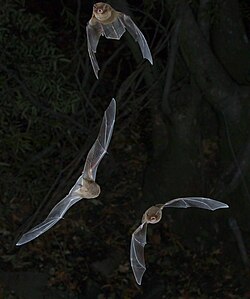| Common name | Scientific name and subspecies | Range | Size and ecology | IUCN status and estimated population |
|---|
| Aellen's long-fingered bat
| M. aelleni
Goodman, Maminirina, Friedli-Weyeneth, Bradman, Christidis, Ruedi, & Appleton, 2010 | Northern Madagascar
 | Size: 4–5 cm (2 in), plus 3–5 cm (1–2 in) tail
3–4 cm (1–2 in) forearm length [4]
Habitat: Forest [5] | LC
Unknown  [5] [5]
|
|---|
| African long-fingered bat
| M. africanus
Sanborn, 1936 | Kenya | Size: Unknown length
4–5 cm (2 in) forearm length [4]
Habitat: Forest [6] | DD
Unknown  [6] [6]
|
|---|
| Common bent-wing bat  | M. schreibersii
(Kuhl, 1817)
| Europe, northern Africa, and western Asia | Size: 5–6 cm (2 in), plus 5–7 cm (2–3 in) tail
4–5 cm (2 in) forearm length [7]
Habitat: Forest, shrubland, grassland, and caves [8] | VU
Unknown  [8] [8]
|
|---|
| Eger's long-fingered bat
| M. egeri
Goodman, Ramasindrazana, Maminirina, Schoeman, & Appleton, 2011 | Eastern Madagascar
 | Size: 4–6 cm (2 in), plus 4–5 cm (2 in) tail
3–4 cm (1–2 in) forearm length [4]
Habitat: Forest [9] | LC
Unknown  [9] [9]
|
|---|
| Glen's long-fingered bat
| M. gleni
Peterson, Egar, & Mitchell, 1995 | Madagascar
 | Size: About 7 cm (3 in), plus 5–7 cm (2–3 in) tail
4–5 cm (2 in) forearm length [4]
Habitat: Caves and forest [10] | LC
Unknown  [10] [10]
|
|---|
| Great bent-winged bat
| M. tristis
(Waterhouse, 1845)
- M. t. celebensis
- M. t. grandis
- M. t. insularis
- M. t. propritristis
- M. t. tristis
| Southeastern Asia
 | Size: 6–8 cm (2–3 in), plus 5–7 cm (2–3 in) tail
4–6 cm (2 in) forearm length [7]
Habitat: Caves and forest [11] | LC
Unknown  [11] [11]
|
|---|
| Greater long-fingered bat  | M. inflatus
Thomas, 1903 | Scattered Sub-Saharan Africa | Size: 5–7 cm (2–3 in), plus 4–6 cm (2 in) tail
4–5 cm (2 in) forearm length [7]
Habitat: Forest and caves [12] | LC
Unknown  [12] [12]
|
|---|
| Griffith's long-fingered bat
| M. griffithsi
Goodman, Maminirina, Bradman, Christidis, & Appleton, 2010 | Southern Madagascar
 | Size: 6–7 cm (2–3 in), plus 5–7 cm (2–3 in) tail
4–5 cm (2 in) forearm length [4]
Habitat: Forest and shrubland [13] | DD
Unknown  [13] [13]
|
|---|
| Griveaud's long-fingered bat
| M. griveaudi
Harrison, 1959 | Northern and western Madagascar
 | Size: 5–6 cm (2 in), plus 3–5 cm (1–2 in) tail
3–4 cm (1–2 in) forearm length [4]
Habitat: Unknown [14] | DD
Unknown  [14] [14]
|
|---|
| Intermediate long-fingered bat
| M. medius
Thomas & Wroughton, 1909 | Southeastern Asia
 | Size: 4–6 cm (2 in), plus 4–6 cm (2 in) tail
4–5 cm (2 in) forearm length [7]
Habitat: Forest and caves [15] | LC
Unknown  [15] [15]
|
|---|
| Least long-fingered bat
| M. minor
Peters, 1866
- M. m. minor
- M. m. occidentalis
| Western and eastern Africa | Size: 5–6 cm (2 in), plus 3–5 cm (1–2 in) tail
3–5 cm (1–2 in) forearm length [7]
Habitat: Unknown [16] | DD
Unknown  [16] [16]
|
|---|
| Lesser long-fingered bat
| M. fraterculus
Thomas & Schwann, 1906 | Southeastern Africa | Size: 4–6 cm (2 in), plus 3–6 cm (1–2 in) tail
4–5 cm (2 in) forearm length [4]
Habitat: Forest, savanna, shrubland, grassland, and caves [17] | LC
Unknown  [17] [17]
|
|---|
| Little bent-wing bat  | M. australis
Tomes, 1858
- M. a. australis
- M. a. solomonensis
- M. a. tibialis
| Southeastern Asia and eastern Australia
 | Size: 3–5 cm (1–2 in), plus 3–5 cm (1–2 in) tail
3–5 cm (1–2 in) forearm length [7]
Habitat: Forest and caves [18] | LC
Unknown  [18] [18]
|
|---|
| Loyalty bent-winged bat
| M. robustior
Revilliod, 1914 | New Caledonia | Size: 4–5 cm (2 in), plus 3–5 cm (1–2 in) tail
3–5 cm (1–2 in) forearm length [7]
Habitat: Forest and caves [19] | EN
Unknown  [19] [19]
|
|---|
| Madagascar long-fingered bat
| M. brachytragos
Goodman, Maminirina, Bradman, Christidis, & Appleton, 2009 | Northern and western Madagascar
 | Size: 4–5 cm (2 in), plus 3–5 cm (1–2 in) tail
3–4 cm (1–2 in) forearm length [4]
Habitat: Forest and rocky areas [20] | LC
Unknown  [20] [20]
|
|---|
| Maghrebian bent-wing bat
| M. maghrebensis
Puechmaille, Allegrini, Benda, Gürün, Srámek, Ibañez, Juste, & Bilgin, 2014 | Northwestern Africa | Size: About 6 cm (2 in), plus about 6 cm (2 in) tail
4–5 cm (2 in) forearm length [7]
Habitat: Forest and shrubland [21] | NT
Unknown  [21] [21]
|
|---|
| Mahafaly long-fingered bat
| M. mahafaliensis
Goodman, Maminirina, Bradman, Christidis, & Appleton, 2009 | Southern Madagascar
 | Size: 4–5 cm (2 in), plus 3–5 cm (1–2 in) tail
3–4 cm (1–2 in) forearm length [4]
Habitat: Rocky areas, shrubland, and forest [22] | LC
Unknown  [22] [22]
|
|---|
| Major's long-fingered bat
| M. majori
Thomas, 1906 | Madagascar
 | Size: 6–7 cm (2–3 in), plus 5–6 cm (2 in) tail
4–5 cm (2 in) forearm length [4]
Habitat: Forest and caves [23] | LC
Unknown  [23] [23]
|
|---|
| Manavi long-fingered bat  | M. manavi
Thomas, 1906 | Central Madagascar
 | Size: About 5 cm (2 in), plus about 4 cm (2 in) tail
3–4 cm (1–2 in) forearm length [4]
Habitat: Forest, rocky areas, and caves [24] | LC
Unknown  [24] [24]
|
|---|
| Montagne d'Ambre long-fingered bat
| M. ambohitrensis
Goodman & Ramasindrazana, 2015 | Northern Madagascar | Size: 5–6 cm (2 in), plus 4–5 cm (2 in) tail
3–5 cm (1–2 in) forearm length [4]
Habitat: Forest [25] | LC
Unknown  [25] [25]
|
|---|
| Natal long-fingered bat  | M. natalensis
Smith, 1834
- M. n. arenarius
- M. n. natalensis
| Southern and eastern Africa and Arabian Peninsula | Size: 5–7 cm (2–3 in), plus 4–6 cm (2 in) tail
4–5 cm (2 in) forearm length [4]
Habitat: Savanna, shrubland, caves, and desert [26] | LC
Unknown  [26] [26]
|
|---|
| Newton's long-fingered bat
| M. newtoni
Bocage, 1889 | São Tomé and Príncipe | Size: About 5 cm (2 in), plus about 4 cm (2 in) tail
3–4 cm (1–2 in) forearm length [7]
Habitat: Forest [27] | DD
Unknown  [27] [27]
|
|---|
| Pale bent-wing bat
| M. pallidus
Thomas, 1907 | Western Asia | Size: 5–7 cm (2–3 in), plus 5–7 cm (2–3 in) tail
4–5 cm (2 in) forearm length [7]
Habitat: Caves and desert [28] | NT
Unknown  [28] [28]
|
|---|
| Peterson's long-fingered bat
| M. petersoni
Goodman, Bradman, Maminirina, Ryan, Christidis, & Appleton, 2008 | Southeastern Madagascar
 | Size: 4–5 cm (2 in), plus 3–5 cm (1–2 in) tail
3–5 cm (1–2 in) forearm length [4]
Habitat: Forest [29] | DD
Unknown  [29] [29]
|
|---|
| Philippine long-fingered bat
| M. paululus
Hollister, 1913 | Southeastern Asia
 | Size: 4–6 cm (2 in), plus 3–5 cm (1–2 in) tail
3–4 cm (1–2 in) forearm length [7]
Habitat: Forest and caves [30] | LC
Unknown  [30] [30]
|
|---|
| Shortridge's long-fingered bat
| M. shortridgei
Laurie & Hill, 1957 | Indonesia | Size: 3–5 cm (1–2 in), plus 3–5 cm (1–2 in) tail
3–4 cm (1–2 in) forearm length [7]
Habitat: Unknown [31] | DD
Unknown  [31] [31]
|
|---|
| Small bent-winged bat
| M. pusillus
Dobson, 1876 | Southeastern Asia
 | Size: 3–5 cm (1–2 in), plus 4–6 cm (2 in) tail
3–5 cm (1–2 in) forearm length [7]
Habitat: Forest and caves [32] | LC
Unknown  [32] [32]
|
|---|
| Small melanesian long-fingered bat  | M. macrocneme
Revilliod, 1914 | New Caledonia and New Guinea | Size: 4–5 cm (2 in), plus 4–6 cm (2 in) tail
3–5 cm (1–2 in) forearm length [7]
Habitat: Forest, shrubland, grassland, and caves [33] | LC
Unknown  [33] [33]
|
|---|
| Sororcula long-fingered bat
| M. sororculus
Goodman, Ryan, Maminirina, Fahr, Christidis, & Appleton, 2007 | Madagascar
 | Size: 5–6 cm (2 in), plus 5–6 cm (2 in) tail
4–5 cm (2 in) forearm length [4]
Habitat: Savanna, shrubland, and rocky areas [34] | LC
Unknown  [34] [34]
|
|---|
| Southeast Asian long-fingered bat
| M. fuscus
Bonhote, 1902 | Japan | Size: 4–6 cm (2 in), plus 5–6 cm (2 in) tail
4–5 cm (2 in) forearm length [7]
Habitat: Forest, inland wetlands, and caves [35] | EN
Unknown  [35] [35]
|
|---|
| Western bent-winged bat
| M. magnater
Sanborn, 1931
- M. m. macrodens
- M. m. magnater
| Southeastern Asia
 | Size: 5–8 cm (2–3 in), plus 5–7 cm (2–3 in) tail
4–6 cm (2 in) forearm length [7]
Habitat: Forest and caves [36] | LC
Unknown  [36] [36]
|
|---|






















